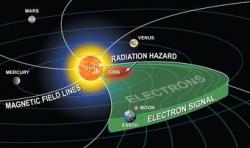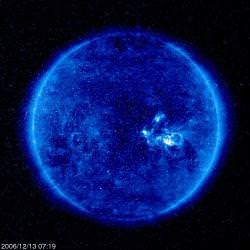Highly energetic solar particles are generated by solar flares and can be harmful to astronauts and sensitive satellite circuits. Solar flares are most likely to occur during periods of heightened solar activity (i.e. during solar maximum at the peak of the 11 year solar cycle), and future manned missions will need to be highly cautious not to be unprotected in space at these times. Many attempts are underway at forecasting solar activity so “solar storms” can be predicted, but a form of early warning system is required to allow time for astronauts to seek cover and satellites put in a low-power state. Now, using the Solar and Heliospheric Observatory (SOHO), scientists are testing a new method of detecting high energy solar ions, in real-time.
Using SOHO as an early warning system isn’t a new idea. Ideally positioned at the Sun-Earth First Lagrange Point (L1), SOHO orbits its little island of gravitational stability in direct line of sight to the Sun, 1.5 million km from the Earth. Anything that comes from the Sun will have to pass through the L1 point, firing through any robotic observers positioned there.
SOHO is in good company. Also positioned at the L1point is the Advanced Composition Explorer (ACE)Â that takes measurements of the solar wind as solar particles continue their way toward the Earth. However, the advanced instrumentation on SOHO allows it to detect very fast electrons (near-relativistic) as they are generated by the Sun. The Comprehensive Suprathermal and Energetic Particle Analyzer (COSTEP) instrument onboard SOHO has provided data about highly energetic particles since 1995, but it’s never been in real-time. Now, using a new technique, solar scientists are able to receive particle data with an hour warning of an impending storm of energetic ions.

When a flare explodes via magnetic interactions on the Sun, electrons and ions are accelerated and burst into space. Travelling at high speed, electrons reach SOHO much quicker than the heavier ions. What’s more, the relativistic electrons are harmless, so they provide an ideal, safe, indicator that the damaging ions are following behind.
The forecasting method was developed eight months ago by Dr Arik Posner (Southwest Research Institute, USA) and scientists from the University of Kiel (Germany), NASA’s Goddard Space Flight Center (USA) and the University of Turku (Finland). Oliver Rother from the University of Kiel has seen the potential for the new real-time system and explains, “We were so excited by Posner’s project that we immediately teamed up and developed new software that displays the data and can give a warning three minutes after taking the measurements 1.5 million km away.”
This is obviously good news for any astronaut in Earth orbit, but generally they are protected from intermediate solar storms as they are within the protective shield of the magnetosphere. This system will be most useful for the future colonists of the Moon and any long-haul manned missions to Mars. It may only be an hours warning, but that hour could make all the difference between mission success and mission failure.
Source: SpaceRef.com


If such a a system has been already developed and has been proven to be reliable, then we can stop money spending für further activities on SW prediction and warning. I have doubt that the data and methods are reliable enough for safe forecasting. False alarms can produce enormous costs and have implications on other disciplines. On the other hand I do not see adequate satellites except SOHO at L1, which can meet the requirements in the next decade.
wow ang ganda
this image is very very wonderful picture.i love it